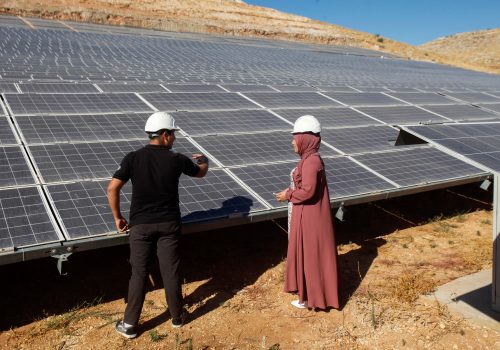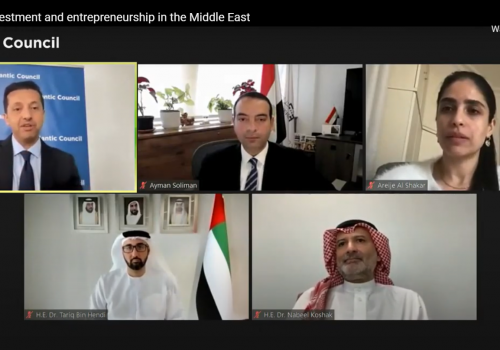September 22, 2022
Egypt is hosting COP27. What are the expectations?
As the host country for the 2022 United Nations Climate Change Conference (COP27) from November 6-18, Egypt has a huge role to play during its presidency of the event, as all eyes will be geared towards how the country can lead by example. To put things in perspective, with 1.3 percent of the world’s population, Egypt accounts for only 0.6 percent of global greenhouse gas emissions (GHG) and ranks twenty-eighth on the global list of polluters. This number appears to be relatively small from a global perspective. Regionally, however, Egypt contributes 31 percent of the overall GHG emissions from North Africa and 13 percent of the overall GHG emissions from the entire African continent. Thus, Egypt has a great responsibility to establish a pathway towards a green energy transition.
This year, Egypt’s presidency for COP is very important as a middle-income, African, and Middle Eastern country hosting this event. Egypt may, therefore, be able to influence the agenda items and bring more focus to Africa’s increasing needs for adaptation and mitigation financing.
The agenda for COP27 includes four main items to be discussed: climate finance, adaptation, loss and damage, and increased ambition. On climate finance, there is a need to ensure that developed countries will fulfill their commitment to developing countries in regard to the $100 billion per year financing pledge, as promised in COP15 in Copenhagen. Since the establishment of the Paris Climate Accords in 2015, there hasn’t been a single year where the $100 billion per year financing target has been met. The closest registered record towards this target was in 2021, where $80 billion were raised through public and private sources.
There is a serious need to reach this goal as climate impacts are causing global suffering on a rampant scale. In addition to the $100 billion goal, there also is a need to agree on a post-2025 climate finance arrangement that is significantly larger in number, in addition to setting up adequate rules to enforce this commitment.
On adaptation, COP27 is considered to be an ‘African COP,’ as it is taking place in one of the continents most effected by climate change. Therefore, stakeholders are expecting to witness a higher political desire to increase global funding for adaptation policies. Currently, 80 percent of the overall climate finance portfolio is dedicated to mitigation, while only 20 percent goes to adaptation. This is often due to the fact that mitigation projects are bankable projects with decent return on investment potential, such as solar and wind energy projects.
However, adaptation projects are less investible by nature, as they are geared towards assisting local communities to adapt to the consequences of the changing climate. These projects are often not bankable and less appealing to financiers. In addition, adaptation projects are often needed by the most vulnerable communities, which often lack the capacity to develop the sophisticated proposals for climate finance that can garner support from financial institutions, agencies, or governments. So, this year, there is a direct need to obtain assistance for one of the most vulnerable continents and help them adapt to climate change in a fair and just manner.
Third, loss and damage has become a contentious subject that has been discussed for several years, with no consensus on any enforceable work plan. Some countries will have complete losses and irreversible damage due to climate change, whether it relates to a small island state that will be completely inundated from sea level rise; or the complete bleaching of coral reefs in some seas; or, the extinction of particular flora and fauna from ecosystems based on global warming. The topic can be divided into economic losses that include damages to resources and goods and services, such as agriculture, infrastructure, tourism, etc., and non-economic losses that include loss of family members, disappearance of culture and ways of living, or migration from one’s home.
Loss and damage differ from mitigation and adaptation, in that it tackles how to help people after they have experienced climate-related impacts, while mitigation works on preventing it and adaptation on minimizing it. The Paris Agreement made only the intention to address loss and damage with technical assistance, but explicitly it did not include any liability or compensation for it by developed countries. There have been several attempts to establish a finance mechanism for loss and damage, but they have repeatedly failed.
The problem also lies in criteria setting towards who gets priority and why. Do entire populations that have to be relocated (due to their homes on an island being inundated) take precedence over crops—which feed the poor—that may go instinct? Not only is the criteria and priority setting a daunting task, but the mere request for additional financing from the international community for ‘loss and damage’ has been completely pushed back in previous negotiation rounds by both the United States and the European Union. Hence, setting up a financing facility will take center stage at COP27.
Finally, the fourth agenda point is increasing ambition. This entails consolidating the concurrent political commitments by different stakeholders and the wider global community towards the climate cause. The February report of the Intergovernmental Panel on Climate Change stated that we must stay below a 1.5 °C temperature increase mark to avoid a climate disaster, and that we only have a decade remaining until the carbon budget is used up entirely. The report also mentioned that, by 2030, emission levels should be halved to meet this target. In other words, the international community has less than ten years to act.
Based on the 2021 Glasgow Climate Pact, if all Nationally Determined Contributions (NDC) targets that were pledged for the Paris agreement were implemented, the international community would still head towards a 2.4°C increase, with a worst-case scenario of 2.8°C—if not all pledges are met—and a best-case scenario of 1.8 °C—if all new actions in Glasgow are implemented. This is still above the 1.5 °C mark. Therefore, the expectations in Sharm el-Sheikh is that all countries would increase their ambitions and place new pledges to reduce their emissions and stay below the 1.5 °C mark.
As a new study reveals, Egypt and the Middle East are warming up faster than the rest of the world, with a predicted 5°C increase in warming by the end of the century. There is also much at stake in Sharm el-Sheikh, as the war in Ukraine is affecting food and energy prices and availability. Egypt has a significant role to play in Sharm el-Sheikh to promote these four key agenda items highlighted above. Egypt is also expected to continue to voice the demands and expectations of the global south—especially those of its direct African neighbors.
Lama El Hatow is a nonresident fellow with the Atlantic Council’s empowerME Initiative. Lama has fifteen years of work experience in the environmental field, eleven of which as an environmental and social specialist at the International Finance Corporation.
Further reading
Thu, Aug 25, 2022
Brown-to-green subsidy swaps in MENA are long overdue. Here’s why.
MENASource By Amin Mohseni-Cheraghlou
Reforms in fossil fuel subsidies can help address many challenges and could result in many benefits for the MENA region.
Thu, Mar 25, 2021
‘It’s not a zero-sum game’: MENA officials agree that regional integration is key to growth
MENASource By
Atlantic Council’s empowerME initiative and the King Faisal Center for Research and Islamic Studies co-hosted an event that discussed strategies for building regional cooperation to create a more attractive investment landscape and productive entrepreneurial ecosystem. These are some key takeaways.
Tue, Sep 29, 2020
Absence of PhD programs contributes to weak research and development in the Gulf
MENASource By
The production of new knowledge is a very complex process and many factors contribute to the low levels of innovation exhibited by the Gulf countries. One factor that plays a role is the structure of tertiary education—particularly PhD programs.
Image: In this photo illustration, a woman's silhouette holds a smartphone with the 2022 United Nations Climate Change Conference COP27 logo in the background. The 2022 United Nations Climate Change Conference COP27 event will take place from the 7-18 November 2022, in Sharm El-Sheikh, Egypt. (Photo by Rafael Henrique / SOPA Images/Sipa USA)


